University Name: Work and Organizations - Workplace Changes Report
VerifiedAdded on 2023/06/05
|7
|1351
|201
Report
AI Summary
This report examines the significant transformations occurring in modern organizations, including the impact of technology and evolving employment arrangements. It explores the shift towards work-life balance, increased employee collaboration, and the implications of these changes on both managers and staff. The report highlights the benefits of flexible working arrangements, such as improved employee morale and reduced turnover, while also addressing the challenges of high employee turnover, the need for upskilling, and the increasing role of artificial intelligence in the future workplace. It provides insights into how organizations can adapt to these trends to maintain a productive and engaged workforce. The report concludes by emphasizing the importance of strategic human resource management to navigate these changes effectively. The report includes references from various academic sources to support its claims.
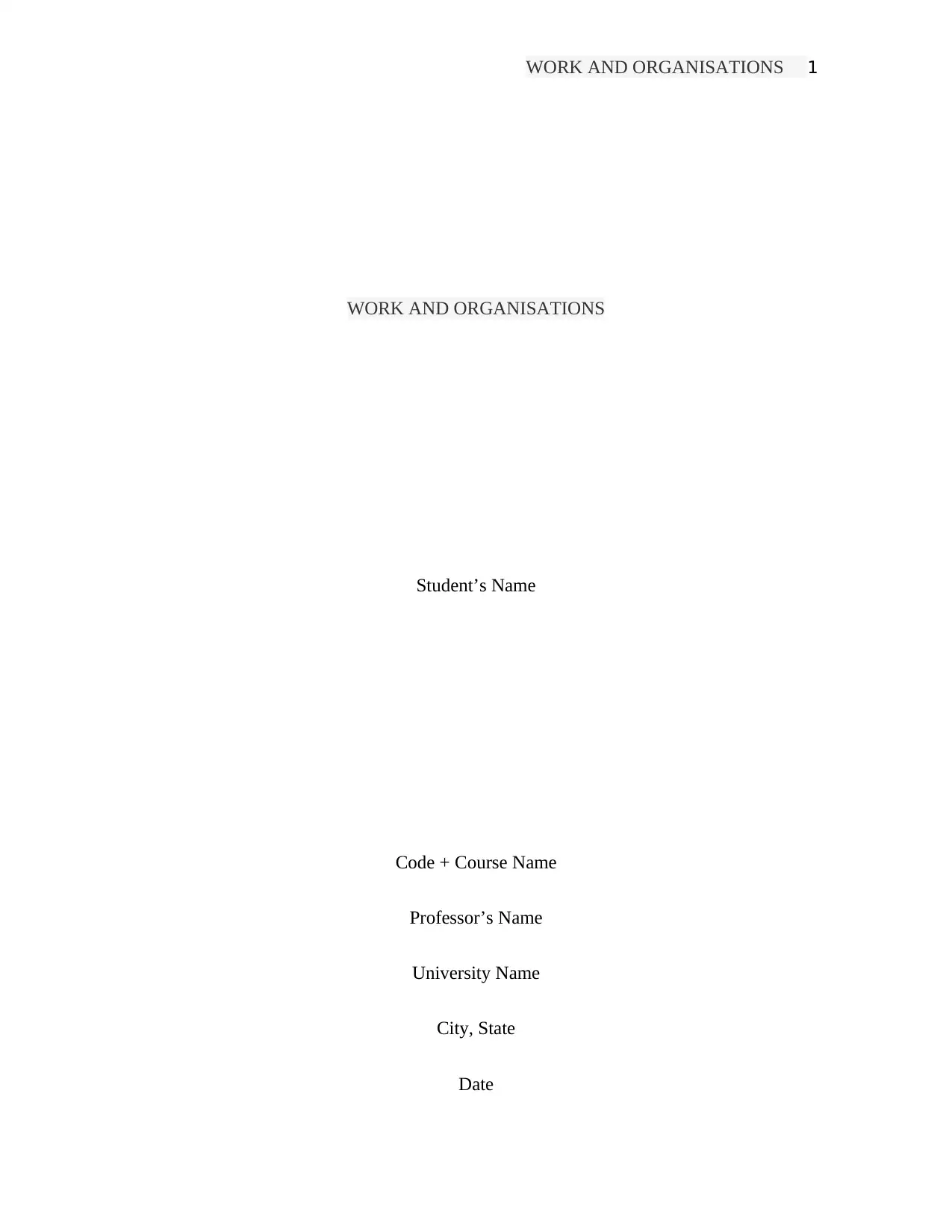
WORK AND ORGANISATIONS 1
WORK AND ORGANISATIONS
Student’s Name
Code + Course Name
Professor’s Name
University Name
City, State
Date
WORK AND ORGANISATIONS
Student’s Name
Code + Course Name
Professor’s Name
University Name
City, State
Date
Paraphrase This Document
Need a fresh take? Get an instant paraphrase of this document with our AI Paraphraser
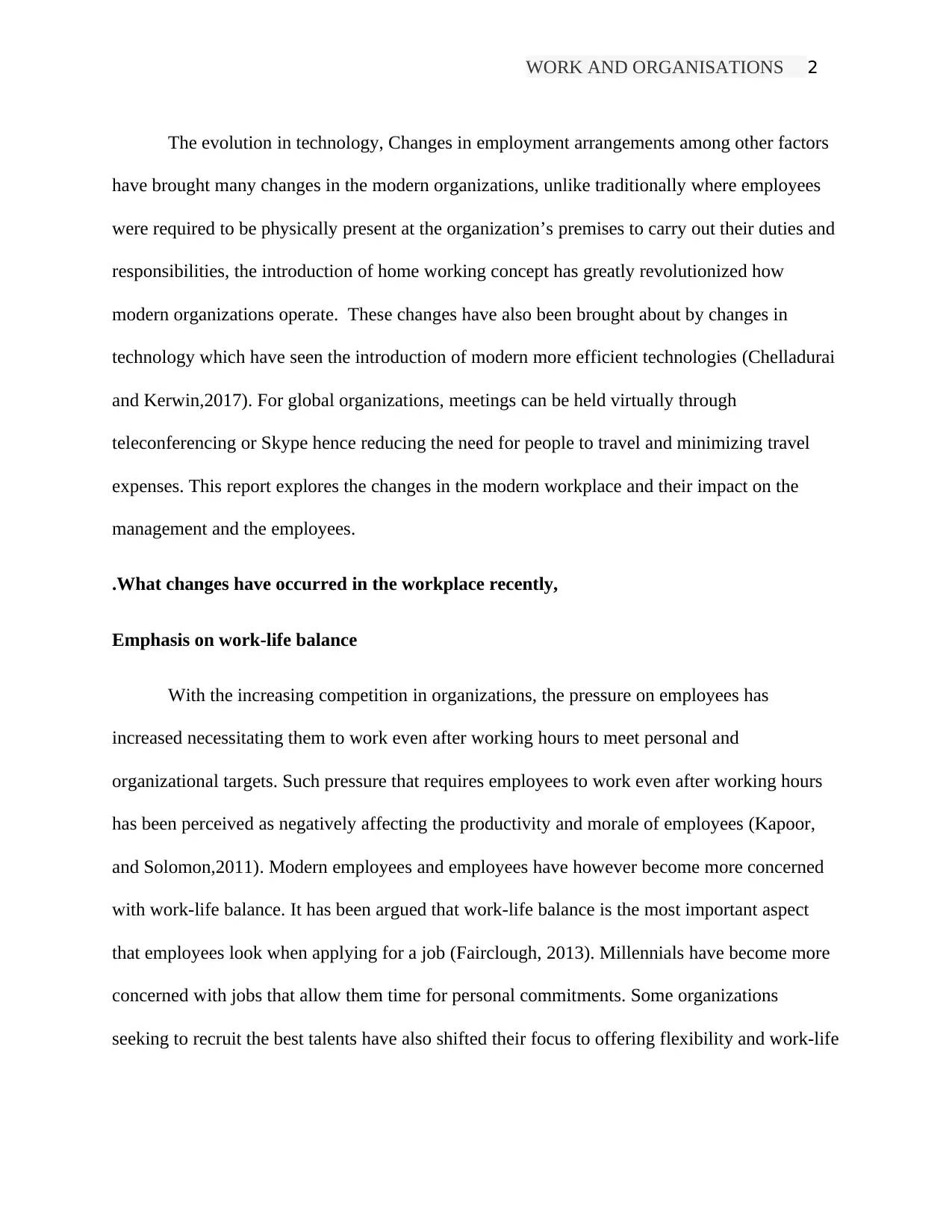
WORK AND ORGANISATIONS 2
The evolution in technology, Changes in employment arrangements among other factors
have brought many changes in the modern organizations, unlike traditionally where employees
were required to be physically present at the organization’s premises to carry out their duties and
responsibilities, the introduction of home working concept has greatly revolutionized how
modern organizations operate. These changes have also been brought about by changes in
technology which have seen the introduction of modern more efficient technologies (Chelladurai
and Kerwin,2017). For global organizations, meetings can be held virtually through
teleconferencing or Skype hence reducing the need for people to travel and minimizing travel
expenses. This report explores the changes in the modern workplace and their impact on the
management and the employees.
.What changes have occurred in the workplace recently,
Emphasis on work-life balance
With the increasing competition in organizations, the pressure on employees has
increased necessitating them to work even after working hours to meet personal and
organizational targets. Such pressure that requires employees to work even after working hours
has been perceived as negatively affecting the productivity and morale of employees (Kapoor,
and Solomon,2011). Modern employees and employees have however become more concerned
with work-life balance. It has been argued that work-life balance is the most important aspect
that employees look when applying for a job (Fairclough, 2013). Millennials have become more
concerned with jobs that allow them time for personal commitments. Some organizations
seeking to recruit the best talents have also shifted their focus to offering flexibility and work-life
The evolution in technology, Changes in employment arrangements among other factors
have brought many changes in the modern organizations, unlike traditionally where employees
were required to be physically present at the organization’s premises to carry out their duties and
responsibilities, the introduction of home working concept has greatly revolutionized how
modern organizations operate. These changes have also been brought about by changes in
technology which have seen the introduction of modern more efficient technologies (Chelladurai
and Kerwin,2017). For global organizations, meetings can be held virtually through
teleconferencing or Skype hence reducing the need for people to travel and minimizing travel
expenses. This report explores the changes in the modern workplace and their impact on the
management and the employees.
.What changes have occurred in the workplace recently,
Emphasis on work-life balance
With the increasing competition in organizations, the pressure on employees has
increased necessitating them to work even after working hours to meet personal and
organizational targets. Such pressure that requires employees to work even after working hours
has been perceived as negatively affecting the productivity and morale of employees (Kapoor,
and Solomon,2011). Modern employees and employees have however become more concerned
with work-life balance. It has been argued that work-life balance is the most important aspect
that employees look when applying for a job (Fairclough, 2013). Millennials have become more
concerned with jobs that allow them time for personal commitments. Some organizations
seeking to recruit the best talents have also shifted their focus to offering flexibility and work-life
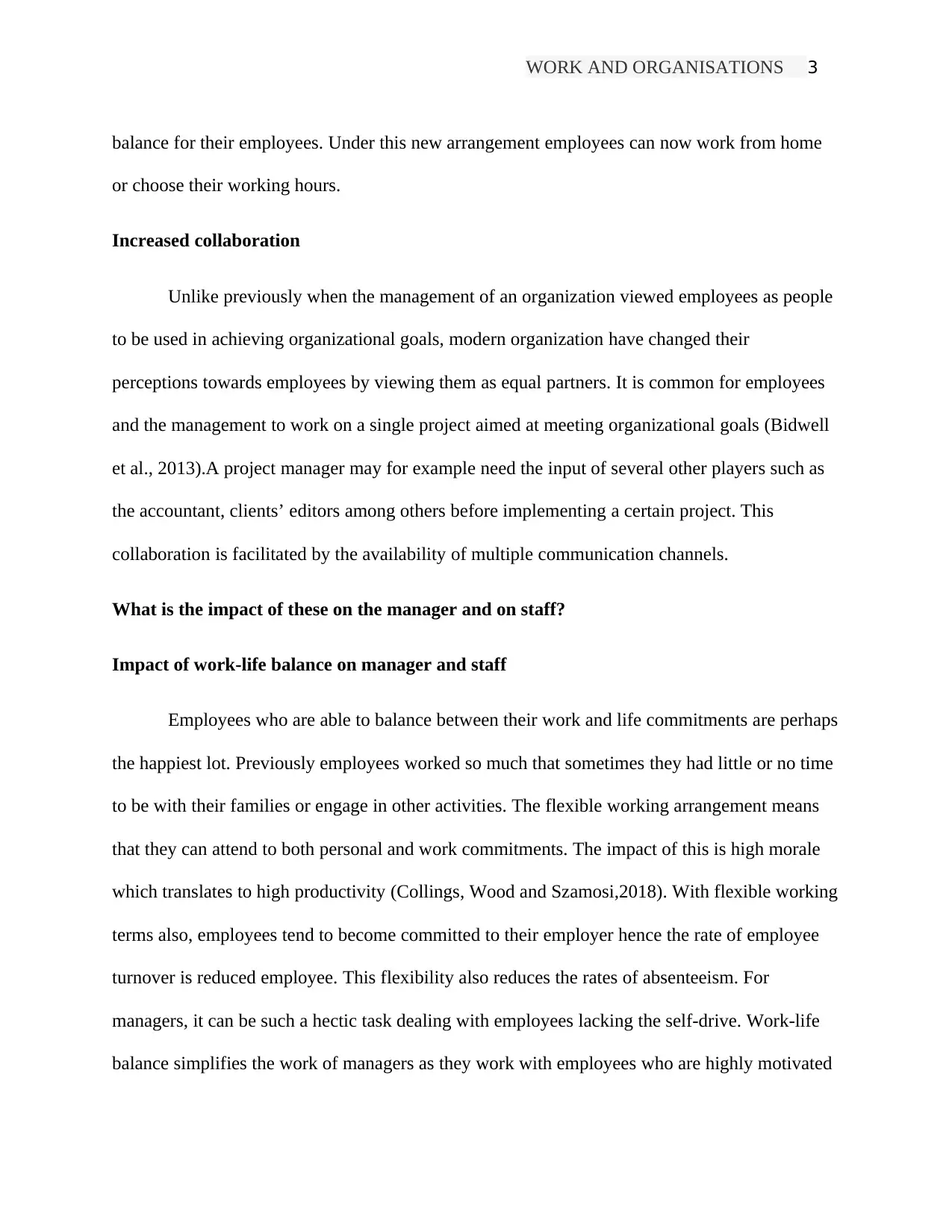
WORK AND ORGANISATIONS 3
balance for their employees. Under this new arrangement employees can now work from home
or choose their working hours.
Increased collaboration
Unlike previously when the management of an organization viewed employees as people
to be used in achieving organizational goals, modern organization have changed their
perceptions towards employees by viewing them as equal partners. It is common for employees
and the management to work on a single project aimed at meeting organizational goals (Bidwell
et al., 2013).A project manager may for example need the input of several other players such as
the accountant, clients’ editors among others before implementing a certain project. This
collaboration is facilitated by the availability of multiple communication channels.
What is the impact of these on the manager and on staff?
Impact of work-life balance on manager and staff
Employees who are able to balance between their work and life commitments are perhaps
the happiest lot. Previously employees worked so much that sometimes they had little or no time
to be with their families or engage in other activities. The flexible working arrangement means
that they can attend to both personal and work commitments. The impact of this is high morale
which translates to high productivity (Collings, Wood and Szamosi,2018). With flexible working
terms also, employees tend to become committed to their employer hence the rate of employee
turnover is reduced employee. This flexibility also reduces the rates of absenteeism. For
managers, it can be such a hectic task dealing with employees lacking the self-drive. Work-life
balance simplifies the work of managers as they work with employees who are highly motivated
balance for their employees. Under this new arrangement employees can now work from home
or choose their working hours.
Increased collaboration
Unlike previously when the management of an organization viewed employees as people
to be used in achieving organizational goals, modern organization have changed their
perceptions towards employees by viewing them as equal partners. It is common for employees
and the management to work on a single project aimed at meeting organizational goals (Bidwell
et al., 2013).A project manager may for example need the input of several other players such as
the accountant, clients’ editors among others before implementing a certain project. This
collaboration is facilitated by the availability of multiple communication channels.
What is the impact of these on the manager and on staff?
Impact of work-life balance on manager and staff
Employees who are able to balance between their work and life commitments are perhaps
the happiest lot. Previously employees worked so much that sometimes they had little or no time
to be with their families or engage in other activities. The flexible working arrangement means
that they can attend to both personal and work commitments. The impact of this is high morale
which translates to high productivity (Collings, Wood and Szamosi,2018). With flexible working
terms also, employees tend to become committed to their employer hence the rate of employee
turnover is reduced employee. This flexibility also reduces the rates of absenteeism. For
managers, it can be such a hectic task dealing with employees lacking the self-drive. Work-life
balance simplifies the work of managers as they work with employees who are highly motivated
⊘ This is a preview!⊘
Do you want full access?
Subscribe today to unlock all pages.

Trusted by 1+ million students worldwide
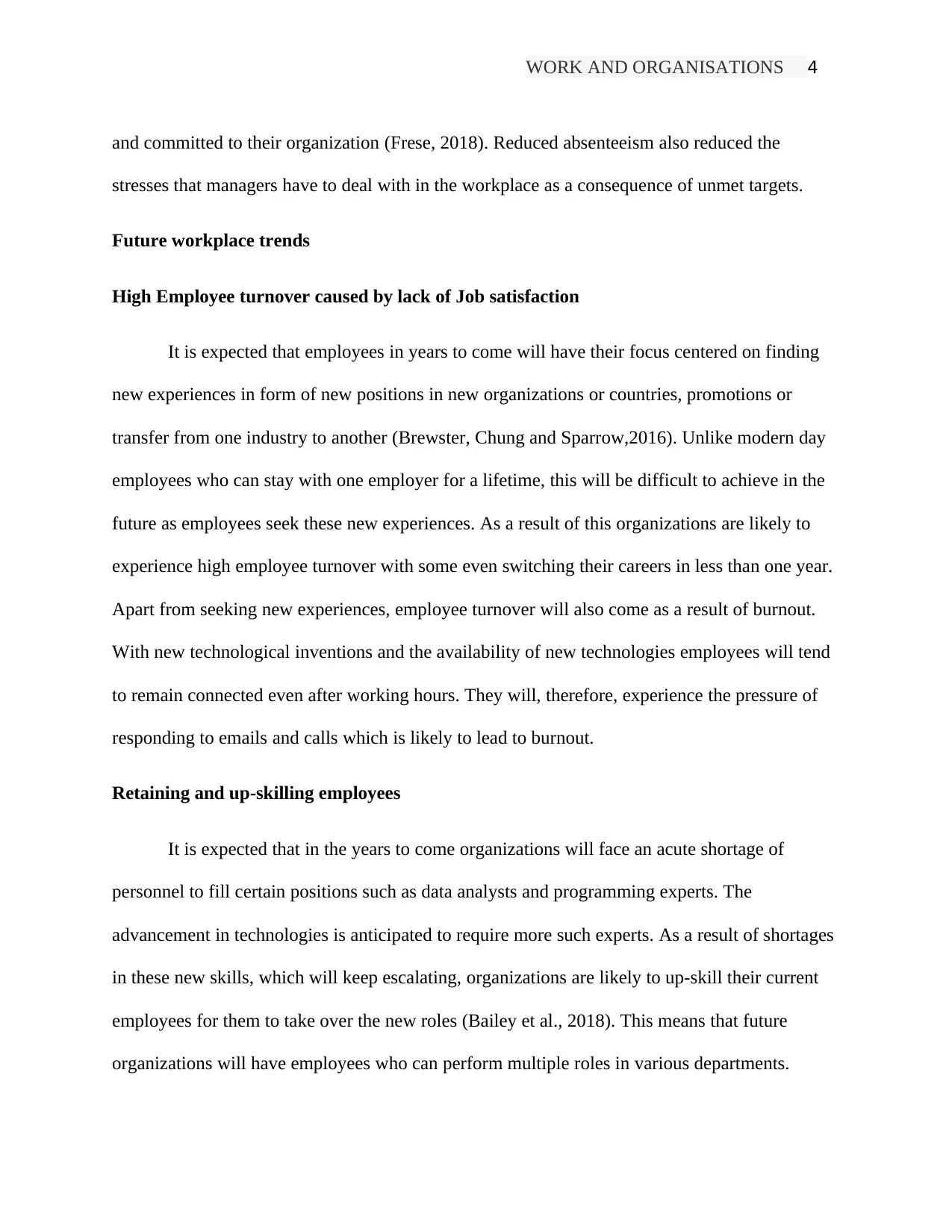
WORK AND ORGANISATIONS 4
and committed to their organization (Frese, 2018). Reduced absenteeism also reduced the
stresses that managers have to deal with in the workplace as a consequence of unmet targets.
Future workplace trends
High Employee turnover caused by lack of Job satisfaction
It is expected that employees in years to come will have their focus centered on finding
new experiences in form of new positions in new organizations or countries, promotions or
transfer from one industry to another (Brewster, Chung and Sparrow,2016). Unlike modern day
employees who can stay with one employer for a lifetime, this will be difficult to achieve in the
future as employees seek these new experiences. As a result of this organizations are likely to
experience high employee turnover with some even switching their careers in less than one year.
Apart from seeking new experiences, employee turnover will also come as a result of burnout.
With new technological inventions and the availability of new technologies employees will tend
to remain connected even after working hours. They will, therefore, experience the pressure of
responding to emails and calls which is likely to lead to burnout.
Retaining and up-skilling employees
It is expected that in the years to come organizations will face an acute shortage of
personnel to fill certain positions such as data analysts and programming experts. The
advancement in technologies is anticipated to require more such experts. As a result of shortages
in these new skills, which will keep escalating, organizations are likely to up-skill their current
employees for them to take over the new roles (Bailey et al., 2018). This means that future
organizations will have employees who can perform multiple roles in various departments.
and committed to their organization (Frese, 2018). Reduced absenteeism also reduced the
stresses that managers have to deal with in the workplace as a consequence of unmet targets.
Future workplace trends
High Employee turnover caused by lack of Job satisfaction
It is expected that employees in years to come will have their focus centered on finding
new experiences in form of new positions in new organizations or countries, promotions or
transfer from one industry to another (Brewster, Chung and Sparrow,2016). Unlike modern day
employees who can stay with one employer for a lifetime, this will be difficult to achieve in the
future as employees seek these new experiences. As a result of this organizations are likely to
experience high employee turnover with some even switching their careers in less than one year.
Apart from seeking new experiences, employee turnover will also come as a result of burnout.
With new technological inventions and the availability of new technologies employees will tend
to remain connected even after working hours. They will, therefore, experience the pressure of
responding to emails and calls which is likely to lead to burnout.
Retaining and up-skilling employees
It is expected that in the years to come organizations will face an acute shortage of
personnel to fill certain positions such as data analysts and programming experts. The
advancement in technologies is anticipated to require more such experts. As a result of shortages
in these new skills, which will keep escalating, organizations are likely to up-skill their current
employees for them to take over the new roles (Bailey et al., 2018). This means that future
organizations will have employees who can perform multiple roles in various departments.
Paraphrase This Document
Need a fresh take? Get an instant paraphrase of this document with our AI Paraphraser
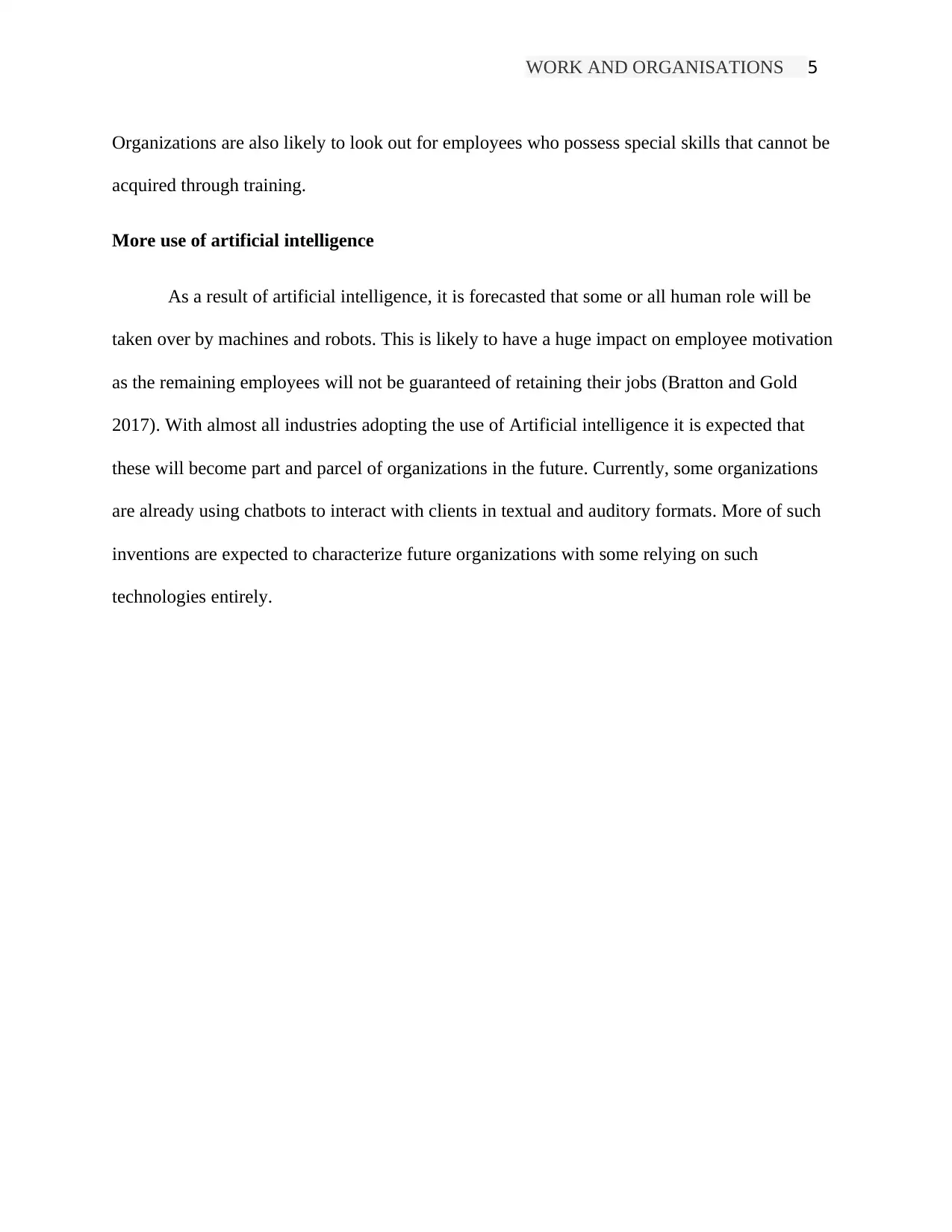
WORK AND ORGANISATIONS 5
Organizations are also likely to look out for employees who possess special skills that cannot be
acquired through training.
More use of artificial intelligence
As a result of artificial intelligence, it is forecasted that some or all human role will be
taken over by machines and robots. This is likely to have a huge impact on employee motivation
as the remaining employees will not be guaranteed of retaining their jobs (Bratton and Gold
2017). With almost all industries adopting the use of Artificial intelligence it is expected that
these will become part and parcel of organizations in the future. Currently, some organizations
are already using chatbots to interact with clients in textual and auditory formats. More of such
inventions are expected to characterize future organizations with some relying on such
technologies entirely.
Organizations are also likely to look out for employees who possess special skills that cannot be
acquired through training.
More use of artificial intelligence
As a result of artificial intelligence, it is forecasted that some or all human role will be
taken over by machines and robots. This is likely to have a huge impact on employee motivation
as the remaining employees will not be guaranteed of retaining their jobs (Bratton and Gold
2017). With almost all industries adopting the use of Artificial intelligence it is expected that
these will become part and parcel of organizations in the future. Currently, some organizations
are already using chatbots to interact with clients in textual and auditory formats. More of such
inventions are expected to characterize future organizations with some relying on such
technologies entirely.
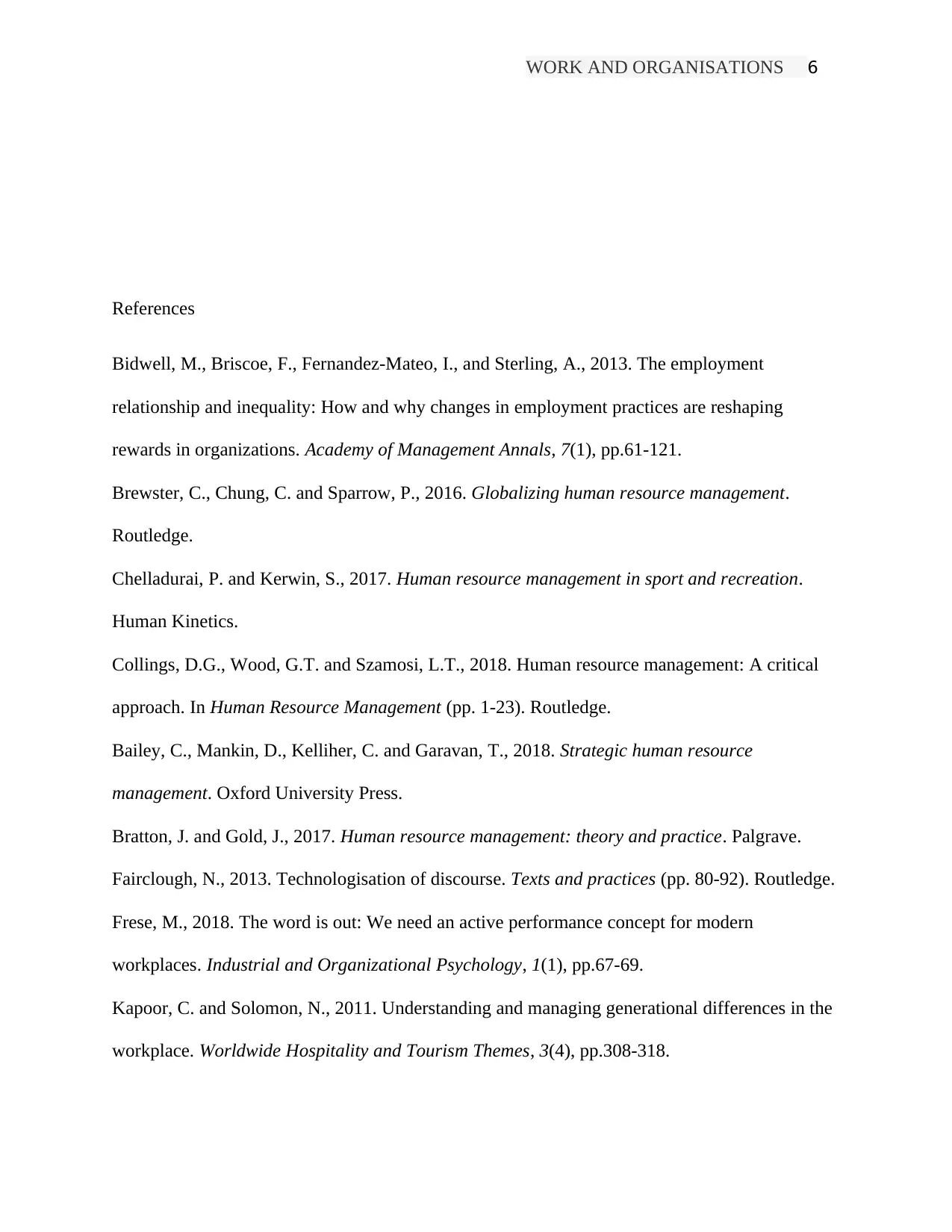
WORK AND ORGANISATIONS 6
References
Bidwell, M., Briscoe, F., Fernandez-Mateo, I., and Sterling, A., 2013. The employment
relationship and inequality: How and why changes in employment practices are reshaping
rewards in organizations. Academy of Management Annals, 7(1), pp.61-121.
Brewster, C., Chung, C. and Sparrow, P., 2016. Globalizing human resource management.
Routledge.
Chelladurai, P. and Kerwin, S., 2017. Human resource management in sport and recreation.
Human Kinetics.
Collings, D.G., Wood, G.T. and Szamosi, L.T., 2018. Human resource management: A critical
approach. In Human Resource Management (pp. 1-23). Routledge.
Bailey, C., Mankin, D., Kelliher, C. and Garavan, T., 2018. Strategic human resource
management. Oxford University Press.
Bratton, J. and Gold, J., 2017. Human resource management: theory and practice. Palgrave.
Fairclough, N., 2013. Technologisation of discourse. Texts and practices (pp. 80-92). Routledge.
Frese, M., 2018. The word is out: We need an active performance concept for modern
workplaces. Industrial and Organizational Psychology, 1(1), pp.67-69.
Kapoor, C. and Solomon, N., 2011. Understanding and managing generational differences in the
workplace. Worldwide Hospitality and Tourism Themes, 3(4), pp.308-318.
References
Bidwell, M., Briscoe, F., Fernandez-Mateo, I., and Sterling, A., 2013. The employment
relationship and inequality: How and why changes in employment practices are reshaping
rewards in organizations. Academy of Management Annals, 7(1), pp.61-121.
Brewster, C., Chung, C. and Sparrow, P., 2016. Globalizing human resource management.
Routledge.
Chelladurai, P. and Kerwin, S., 2017. Human resource management in sport and recreation.
Human Kinetics.
Collings, D.G., Wood, G.T. and Szamosi, L.T., 2018. Human resource management: A critical
approach. In Human Resource Management (pp. 1-23). Routledge.
Bailey, C., Mankin, D., Kelliher, C. and Garavan, T., 2018. Strategic human resource
management. Oxford University Press.
Bratton, J. and Gold, J., 2017. Human resource management: theory and practice. Palgrave.
Fairclough, N., 2013. Technologisation of discourse. Texts and practices (pp. 80-92). Routledge.
Frese, M., 2018. The word is out: We need an active performance concept for modern
workplaces. Industrial and Organizational Psychology, 1(1), pp.67-69.
Kapoor, C. and Solomon, N., 2011. Understanding and managing generational differences in the
workplace. Worldwide Hospitality and Tourism Themes, 3(4), pp.308-318.
⊘ This is a preview!⊘
Do you want full access?
Subscribe today to unlock all pages.

Trusted by 1+ million students worldwide
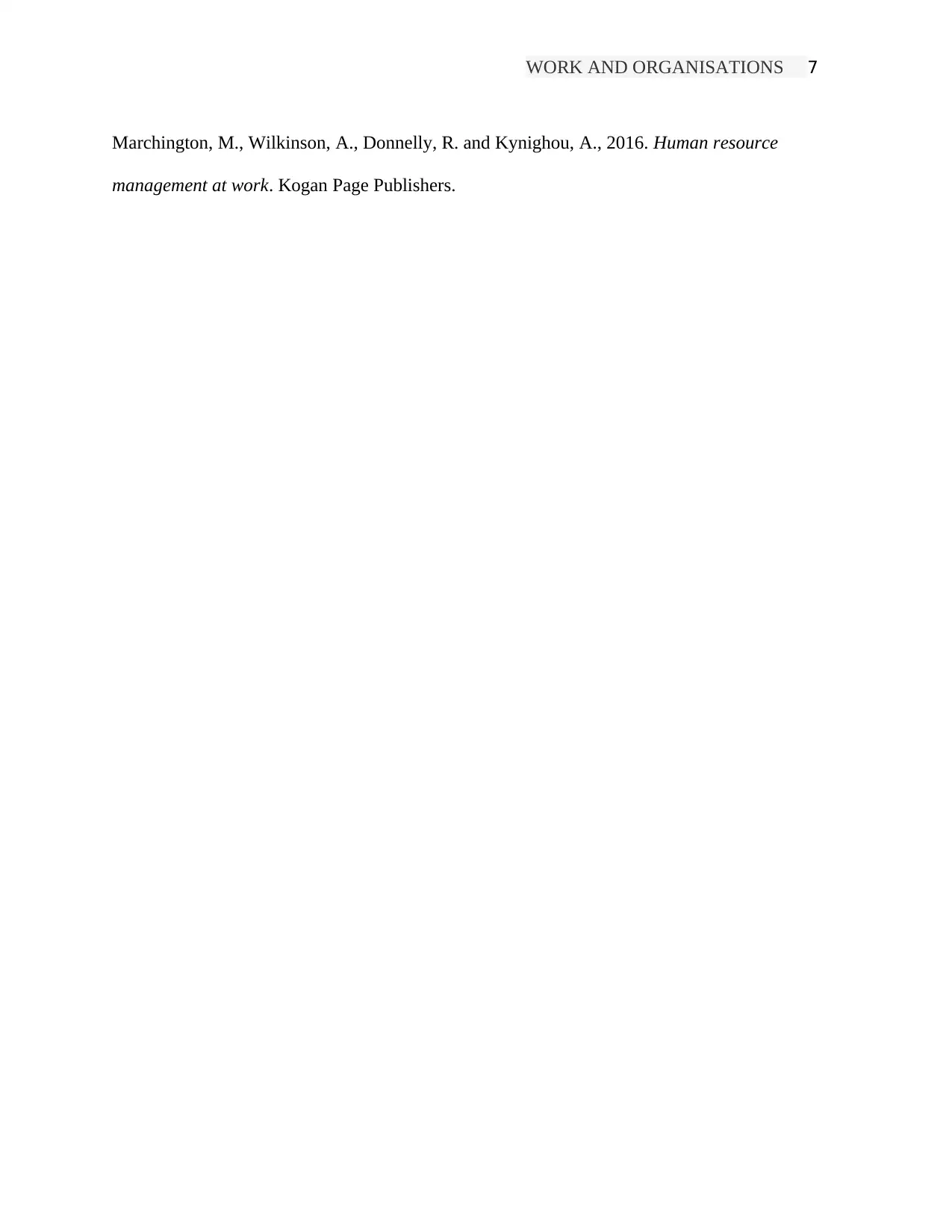
WORK AND ORGANISATIONS 7
Marchington, M., Wilkinson, A., Donnelly, R. and Kynighou, A., 2016. Human resource
management at work. Kogan Page Publishers.
Marchington, M., Wilkinson, A., Donnelly, R. and Kynighou, A., 2016. Human resource
management at work. Kogan Page Publishers.
1 out of 7
Related Documents
Your All-in-One AI-Powered Toolkit for Academic Success.
+13062052269
info@desklib.com
Available 24*7 on WhatsApp / Email
![[object Object]](/_next/static/media/star-bottom.7253800d.svg)
Unlock your academic potential
Copyright © 2020–2025 A2Z Services. All Rights Reserved. Developed and managed by ZUCOL.





